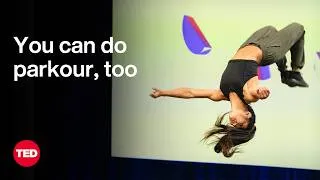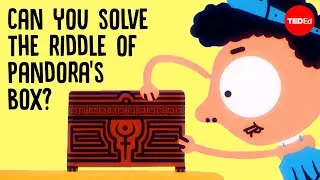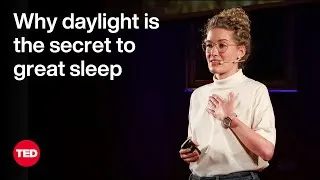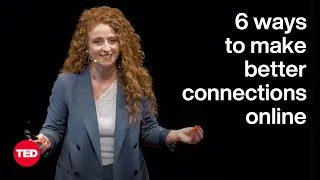This computer is learning to read your mind | DIY Neuroscience, a TED series
127,089 views ・ 2018-09-15
請雙擊下方英文字幕播放視頻。
00:00
Translator: Joseph Geni
Reviewer: Krystian Aparta
0
0
7000
譯者: Joey Chung
審譯者: 至磊Zi Le 黃Ng
00:12
Greg Gage: Mind-reading.
You've seen this in sci-fi movies:
1
12203
2859
葛列格·蓋奇 (GG):讀心術。
你在科幻電影中曾看過:
00:15
machines that can read our thoughts.
2
15086
1857
可以讀出我們想法的機器。
00:16
However, there are devices today
3
16967
1798
然而,如今有很多機器
00:18
that can read the electrical
activity from our brains.
4
18789
2524
可以讀出我們大腦中的電波。
00:21
We call this the EEG.
5
21337
1272
我們稱之為 「腦波圖」。
00:23
Is there information
contained in these brainwaves?
6
23695
2829
這些腦波中含有資訊嗎?
00:26
And if so, could we train a computer
to read our thoughts?
7
26548
2813
如果含有資訊,
我們可以訓練電腦
讀懂我們的思想嗎?
00:29
My buddy Nathan
has been working to hack the EEG
8
29385
2904
我的好友內森一直
致力研究如何破解腦波圖
00:32
to build a mind-reading machine.
9
32313
1676
以建造一台可以讀心的機器。
00:34
[DIY Neuroscience]
10
34013
2457
【DIY 神經科學】
00:36
So this is how the EEG works.
11
36939
1561
先介紹一下腦波圖的原理。
00:38
Inside your head is a brain,
12
38524
1844
你的頭裡有大腦,
00:40
and that brain is made
out of billions of neurons.
13
40392
2558
而大腦是由數十億個神經元構成。
00:42
Each of those neurons sends
an electrical message to each other.
14
42974
3007
每個神經元都在互相傳送電子訊息。
00:46
These small messages can combine
to make an electrical wave
15
46005
2814
這些微小的訊息可以結合在一起,
00:48
that we can detect on a monitor.
16
48843
1570
形成顯示器上探測到的電波。
00:50
Now traditionally, the EEG
can tell us large-scale things,
17
50437
2724
傳統來說,
腦波圖能告訴我們大維度的事情,
00:53
for example if you're asleep
or if you're alert.
18
53185
2350
例如你是睡著還是清醒著。
00:55
But can it tell us anything else?
19
55559
1594
但是它可以告訴我們其它事情嗎?
00:57
Can it actually read our thoughts?
20
57177
1702
它是否能夠讀出我們心中所想?
00:58
We're going to test this,
21
58903
1219
我們要測試這一點,
01:00
and we're not going to start
with some complex thoughts.
22
60146
2623
而我們不會從一些複雜的想法開始。
01:02
We're going to do something very simple.
23
62793
1977
我們會從一些非常簡單的事情開始。
01:04
Can we interpret what someone is seeing
using only their brainwaves?
24
64794
3253
我們只需要依據腦波
就可以判讀一個人看到了什麼嗎?
01:08
Nathan's going to begin by placing
electrodes on Christy's head.
25
68071
3000
內森先在克莉絲蒂的頭上安裝電極。
01:11
Nathan: My life is tangled.
26
71095
1523
內森:我的生命亂成一團。
01:12
(Laughter)
27
72642
1150
(笑聲)
01:14
GG: And then he's going to show her
a bunch of pictures
28
74152
2584
GG:之後他會給她看一些圖片,
01:16
from four different categories.
29
76760
1521
圖片來自四個不同類別。
01:18
Nathan: Face, house, scenery
and weird pictures.
30
78305
2654
內森:面孔、房子、
風景、古怪的圖片。
01:20
GG: As we show Christy
hundreds of these images,
31
80983
2498
GG:當我們向克莉絲蒂
展示數百張這種圖片時,
01:23
we are also capturing the electrical waves
onto Nathan's computer.
32
83505
3543
內森的電腦捕捉了她的腦波。
01:27
We want to see if we can detect
any visual information about the photos
33
87072
3386
我們想知道我們能否偵測
腦波中有關這些圖片的視覺資訊。
01:30
contained in the brainwaves,
34
90482
1352
01:31
so when we're done,
we're going to see if the EEG
35
91858
2331
當實驗結束後,
我們將會看到腦波圖是否可以
告訴我們克莉絲蒂在看哪種圖片,
01:34
can tell us what kind of picture
Christy is looking at,
36
94213
2598
01:36
and if it does, each category
should trigger a different brain signal.
37
96835
3584
即是不同種類的圖片,
會否觸發不同的大腦信號。
01:40
OK, so we collected all the raw EEG data,
38
100443
2628
我們收集完了所有原始腦波圖資料,
01:43
and this is what we got.
39
103095
1150
這是我們的成果。
01:45
It all looks pretty messy,
so let's arrange them by picture.
40
105389
2938
看上去很混亂,
我們來根據圖片類別分類。
01:48
Now, still a bit too noisy
to see any differences,
41
108826
2656
現在,還是有點太雜亂,
無法看出任何區別,
01:51
but if we average the EEG
across all image types
42
111506
3040
但是如果將圖片出現的時間對齊,
01:54
by aligning them
to when the image first appeared,
43
114570
2436
並對每種類別的腦波圖取平均值,
01:57
we can remove this noise,
44
117030
1617
就能移除其中的雜亂。
01:58
and pretty soon, we can see
some dominant patterns
45
118671
2334
很快我們便從各個類別中
看到一些主要的規律。
02:01
emerge for each category.
46
121029
1564
02:02
Now the signals all
still look pretty similar.
47
122617
2156
現在這些信號看起來
仍然是很相似。
02:04
Let's take a closer look.
48
124797
1215
讓我們再仔細看看。
02:06
About a hundred milliseconds
after the image comes on,
49
126036
2525
大約在一張圖片出現一百毫秒後,
02:08
we see a positive bump in all four cases,
50
128585
2628
我們在四個類別中
都看到了正向波動,
02:11
and we call this the P100,
and what we think that is
51
131237
2789
我們把它叫作 P100 ,
我們認為這是當你識別物體時
大腦中發生的活動。
02:14
is what happens in your brain
when you recognize an object.
52
134050
3075
02:17
But damn, look at
that signal for the face.
53
137149
2086
但糟糕了,看看面孔圖片的信號,
02:19
It looks different than the others.
54
139259
1711
它看起來與其他的不同,
02:20
There's a negative dip
about 170 milliseconds
55
140994
2890
在圖片出現後約 170 毫秒,
02:23
after the image comes on.
56
143908
1540
出現了負向波動。
02:25
What could be going on here?
57
145472
1750
這裡可能發生了什麼事?
02:27
Research shows that our brain
has a lot of neurons that are dedicated
58
147246
3240
研究顯示,
我們大腦有大量神經元
專門負責識別人類的面孔,
02:30
to recognizing human faces,
59
150510
1459
02:31
so this N170 spike could be
all those neurons
60
151993
2844
所以這個 N170 腦電負成分
可能是由這些神經元產生
02:34
firing at once in the same location,
61
154861
1985
在同一個地方同時啟動,
02:36
and we can detect that in the EEG.
62
156870
1634
而我們可以在腦波圖中探測到。
02:39
So there are two takeaways here.
63
159083
1820
於是這裡有兩個結論:
02:40
One, our eyes can't really detect
the differences in patterns
64
160927
3085
第一,在沒有進行平均法降噪時,
我們的眼睛不能識別
腦波規律的不同;
02:44
without averaging out the noise,
65
164036
1571
02:45
and two, even after removing the noise,
66
165631
2237
第二,即使移除雜訊後,
02:47
our eyes can only pick up
the signals associated with faces.
67
167892
3001
我們的眼睛也只能
識別出和面孔有關的信號。
02:50
So this is where we turn
to machine learning.
68
170917
2268
於是我們在此轉而借助機器學習。
02:53
Now, our eyes are not very good
at picking up patterns in noisy data,
69
173209
3976
我們的眼睛並不擅長
在雜訊中發現規律,
02:57
but machine learning algorithms
are designed to do just that,
70
177209
2946
但是機器學習演算法的設計
可以解決這類問題。
03:00
so could we take a lot of pictures
and a lot of data
71
180179
3201
所以我們能否將許多圖片和資料
03:03
and feed it in and train a computer
72
183404
1790
輸入到電腦中進行訓練,
03:05
to be able to interpret
what Christy is looking at in real time?
73
185218
3381
從而即時判斷克莉絲蒂
究竟正在看什麼?
03:09
We're trying to code the information
that's coming out of her EEG
74
189088
4117
我們嘗試將她的腦波圖資訊
03:13
in real time
75
193229
1175
進行即時編碼,
03:14
and predict what it is
that her eyes are looking at.
76
194428
2461
並預測她眼睛在看什麼東西。
03:16
And if it works, what we should see
77
196913
1727
如果這樣有效,
我們應該能看到
每當她看到風景的圖片時,
03:18
is every time that she gets
a picture of scenery,
78
198664
2381
03:21
it should say scenery,
scenery, scenery, scenery.
79
201069
2286
機器顯示風景、風景、風景、風景,
03:23
A face -- face, face, face, face,
80
203379
1957
看到面孔──
面孔、面孔、面孔、面孔,
03:25
but it's not quite working that way,
is what we're discovering.
81
205360
3531
但是我們發現,實際上並非如此。
03:33
(Laughter)
82
213385
3548
(笑聲)
03:36
OK.
83
216957
1151
好的。
03:38
Director: So what's going on here?
GG: We need a new career, I think.
84
218132
3382
導演:怎麼了?
GG:我覺得我們應該轉行。
03:41
(Laughter)
85
221538
1070
(笑聲)
03:42
OK, so that was a massive failure.
86
222632
2444
好吧,所以剛剛那個是重大失敗。
03:45
But we're still curious:
How far could we push this technology?
87
225100
3212
但是我們依然好奇:
我們能將這項技術推展到多遠?
03:48
And we looked back at what we did.
88
228336
1640
於是我們回顧做法。
03:50
We noticed that the data was coming
into our computer very quickly,
89
230000
3143
我們發現資料飛快湧入電腦,
03:53
without any timing
of when the images came on,
90
233167
2241
但沒有對圖片出現的時間進行計時,
03:55
and that's the equivalent
of reading a very long sentence
91
235432
2876
這等同於讀一個
在單詞間沒有空格的長句。
03:58
without spaces between the words.
92
238332
1605
03:59
It would be hard to read,
93
239961
1438
這樣的句子很難讀懂,
04:01
but once we add the spaces,
individual words appear
94
241423
3713
但是只要我們添加了空格,
我們就能看到獨立的單詞,
04:05
and it becomes a lot more understandable.
95
245160
2044
句子也就變得容易理解得多,
04:07
But what if we cheat a little bit?
96
247228
1847
但如果我們作一點弊呢?
04:09
By using a sensor, we can tell
the computer when the image first appears.
97
249099
3537
透過使用感測器,
我們能告訴電腦
每張圖片出現的時間。
04:12
That way, the brainwave stops being
a continuous stream of information,
98
252660
3602
這樣,腦波就不再是
一個沒有間斷的資訊串流,
04:16
and instead becomes
individual packets of meaning.
99
256286
2711
而是變成了一個個有意義的封包。
04:19
Also, we're going
to cheat a little bit more,
100
259021
2368
另外,我們還要再作弊一下,
04:21
by limiting the categories to two.
101
261413
1812
把圖片限制到兩個類別。
04:23
Let's see if we can do
some real-time mind-reading.
102
263249
2383
讓我們看看我們是否能夠即時讀心。
04:25
In this new experiment,
103
265656
1235
在這個新實驗中,
04:26
we're going to constrict it
a little bit more
104
266915
2097
我們將限制實驗條件,
04:29
so that we know the onset of the image
105
269036
2252
這樣我們就會知道圖片出現的時間,
04:31
and we're going to limit
the categories to "face" or "scenery."
106
271312
3382
並將類別限制為「面孔」或「風景」。
04:35
Nathan: Face. Correct.
107
275097
1511
內森:面孔,正確。
04:37
Scenery. Correct.
108
277780
1351
風景,正確。
04:40
GG: So right now,
every time the image comes on,
109
280251
2373
GG:所以現在每當圖片出現時,
04:42
we're taking a picture
of the onset of the image
110
282648
2266
我們對圖片出現的時刻進行記錄,
04:44
and decoding the EEG.
111
284938
1695
並對腦波圖解碼。
04:46
It's getting correct.
112
286657
1256
它變得越來越正確。
04:47
Nathan: Yes. Face. Correct.
113
287937
1579
內森:是的,面孔,正確。
04:49
GG: So there is information
in the EEG signal, which is cool.
114
289540
2859
GG:所以腦波圖的信號中
包含資訊,這很棒。
04:52
We just had to align it
to the onset of the image.
115
292423
2537
我們僅僅需要把它
和圖片出現的時刻對齊。
04:55
Nathan: Scenery. Correct.
116
295307
1311
內森:風景,正確。
04:59
Face. Yeah.
117
299344
1150
面孔,沒錯。
05:00
GG: This means there is some
information there,
118
300518
2288
GG:這意味著它包含了一些資訊,
05:02
so if we know at what time
the picture came on,
119
302830
2913
如果我們知道圖片出現的時間,
05:05
we can tell what type of picture it was,
120
305767
1999
我們就有可能判斷
它是哪個類別的圖片,
05:07
possibly, at least on average,
by looking at these evoked potentials.
121
307790
5096
至少一般可以做到,
只要根據這些由圖片誘發的電位。
05:12
Nathan: Exactly.
122
312910
1325
內森:說得沒錯。
05:14
GG: If you had told me at the beginning
of this project this was possible,
123
314259
3521
GG:如果你一開始跟我說,
這個計畫有可能實現,
05:17
I would have said no way.
124
317804
1251
我會說,怎麼可能。
我真的覺得我們不可能做到。
05:19
I literally did not think
we could do this.
125
319079
2000
我們的讀心術實驗真的成功了嗎?
05:21
Did our mind-reading
experiment really work?
126
321103
2066
05:23
Yes, but we had to do a lot of cheating.
127
323193
1975
成功了,但是我們必須作很多弊。
05:25
It turns out you can find
some interesting things in the EEG,
128
325192
2905
結果就是,你能透過腦波圖
發現一些有趣的事,
05:28
for example if you're
looking at someone's face,
129
328121
2290
比如你是否在看某人的臉,
05:30
but it does have a lot of limitations.
130
330435
2157
但它確實有很多限制。
05:32
Perhaps advances in machine learning
will make huge strides,
131
332616
2946
也許機器學習領域的進步
會帶來更多重大突破。
05:35
and one day we will be able to decode
what's going on in our thoughts.
132
335586
3390
有朝一日,我們能夠解碼心中所想。
05:39
But for now, the next time a company says
that they can harness your brainwaves
133
339000
4077
可是就現在來說,
當有公司說它能利用
你的腦波控制設備,
05:43
to be able to control devices,
134
343101
1750
05:44
it is your right, it is your duty
to be skeptical.
135
344875
3310
保持懷疑是你的權利和責任。
New videos
Original video on YouTube.com
關於本網站
本網站將向您介紹對學習英語有用的 YouTube 視頻。 您將看到來自世界各地的一流教師教授的英語課程。 雙擊每個視頻頁面上顯示的英文字幕,從那裡播放視頻。 字幕與視頻播放同步滾動。 如果您有任何意見或要求,請使用此聯繫表與我們聯繫。







